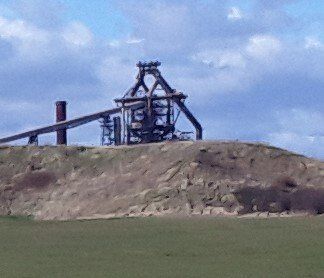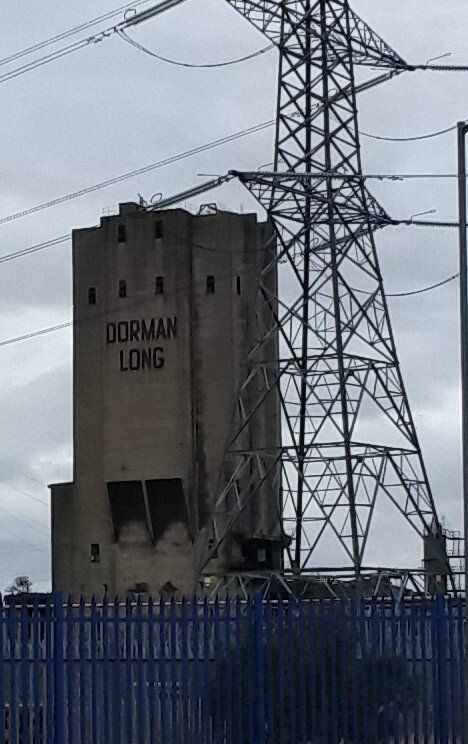Iconoclasts of the Tees Valley:
Meet Teesworks Heritage Taskforce Co-chairs,
Jacob Young MP and Kate Willard OBE
Redcar Blast Furnace Dorman Long Tower , South Bank Steel House, Redcar
Scott Hunter
2 June 2021
The Tees Valley is not short of monuments to its industrial past, from the Brick Train on the Darlington bypass, to the sculptures on the A66 roundabouts, and the Ironstone Mining Museum in Skinningrove. All of them created to celebrate the Tees Valley’s industrial past. Many people see these as fitting tribute to the generations of people whose lives were characterised by danger at work, poverty at home, and massive air pollution everywhere.
Now that the South Tees Site is being redeveloped, a new task has emerged, which is deciding on the preservation of some of its most important structures. Redcar MP and co-chair of Teesworks Heritage Taskforce, Jacob Young, is committed to commemorating this region’s industrial heritage. As he says of one of the iconic structures around the banks of the Tees:
“Now a picture of it hangs proudly in my office in Westminster. For me it's an important reminder of my roots, of where I come from and also of all the potential Teesside has for the future - from the banks of the Tees, we built the world.”
Could that be Redcar Blast Furnace, beloved of artists and photographers that he’s referring to? No. It’s the Dorman Long Tower. The taskforce has recently commissioned an investigation to determine the feasibility of saving it for posterity.
Perhaps this statement from the TVCA could be about the blast furnace:
“We’re delighted to see that this iconic building is being saved and rejuvenated as part of Teesworks’ redevelopment.”
But in fact, that’s not the blast furnace either. That’s Steel House, completed in 1978, former headquarters of British Steel, near the entrance to the Teesworks site.
The future of the blast furnace is actually contained in the January 2021 report of the Heritage Task Force. It is to be demolished, as has now been widely reported, despite an ongoing campaign to save its core.
In its 2019 Masterplan for the South Tees Site, the South Tees Development Corporation committed to retaining the blast furnace as a monument. Following publication of the Heritage Taskforce’s most recent report, however, it agreed to its demolition (at its board meeting on 21 February 2021). Campaigners have complained that the figures presented in a consultancy report prepared by Primetals Ltd were inflated to a ridiculous degree, not least because it included the cost of building a visitors’ centre on the site that no one had asked for.
Taking the plans for the three structures together, the STDC’s curious attitude towards Teesside’s industrial heritage starts to emerge. On the one hand, as Ben Houchen, Tees Valley mayor, says of Steel House:
“We have always been keen to incorporate, where we could, some key elements of the existing site into our bold new vision. When we looked into it further, it was a no-brainer that Steel House should be saved.”
Now you may think that this was a case of simple pragmatism, that a perfectly sound structure like Steel House should be retained. But an entirely different picture emerges once the chairpersons of the Heritage Taskforce make their feelings known. Now it’s being retained because it’s iconic. Odd then, that they should welcome the building being extensively redesigned:
“These designs breathe new life into the structure which holds fond memories for the thousands of people who have worked there over the years.
“We have been working with the Mayor to stress the importance of keeping those assets on site that are commercially viable and possible to renovate. It is important to ensure that buildings like Steel House and their rich and strong heritage, help forge a dynamic future for the site and the surrounding communities.
“We really can’t wait to see how these designs become a reality.”
Many people might think that once the building has been extensively remodelled, it will no longer be the iconic structure it is alleged to be today. Were it iconic, what they’re planning would be tantamount to giving the Mona Lisa a coat of emulsion. But it isn’t. It’s a concrete protrusion on the landscape, largely hidden behind trees, that resembles nothing more than an outsize WWII gun emplacement.
And as for the ‘rich and strong heritage’ of Steel House, it begins with privatisation of the steel industry under Margaret Thatcher, and ends with the termination of steelmaking on Teesside at the hands of George Osborne. Thus, a monument to the destructive impulse of neo-liberalism.
If all of this is lost on Jacob Young, that is perhaps understandable. He was appointed to a role for which he has absolutely no qualifications or relevant experience. But then he is not steering the heritage taskforce alone. By his side is co-chair, Kate Willard OBE, who, according to the Teesworks website “has a wealth of experience in heritage and arts.” So that’s reassuring.
But what is her experience, exactly? Currently she is Stobart’s representative on the board of Goosepool 2019, Teesside Airport’s holding company. But,it turns out that her c.v. is fairly extensive. In 2017, she was appointed as chair of the Arts Council North, so that at least accounts for the arts bit of her ‘wealth of experience’.
She was appointed to that role in 2017, at the same time that Elisabeth Murdoch, daughter of Rupert, became a National Council member. The latter appointment caused a bit of a stir, so no one really paid much attention to Kate Willard, or questioned what had prompted them to appoint her. And in any case, Nicholas Serota had only recently been appointed chair, which has also stirred some controversy given his extreme right-wing views (not to mention employment practices while at the Tate Gallery). Yes, 2017 was palace coup time at the Arts Council.
Now, it would be unfair to tar Kate Willard with the same brush as these two, as she has not said or done anything controversial. In fact, there is no information in the public domain to indicate that she has done anything much at all. While the chairs of Arts Council Midlands and Arts Council South East fill their Twitter feeds with news of upcoming arts events in their regions, Kate Willard fills hers with news of developments at Carlisle Airport (almost to the exclusion of all else). You start to wonder how she ever got the job at all.
Look at her other appointments, however, and things start to fall into place. First of all, there’s her position as chair of the Towns Fund , which places her in an influential position in the Conservative party. And, in fact, in her capacity as the Thames Estuary Envoy and Chair at the Thames Estuary Growth Board she was recently profiled in Conservative Home. Now, while this still gives us no clue as to her wealth of experience in heritage, it does indicate that she is involved in the creation of freeports (as, of course, is Jacob Young, who has recently been appointed to the TVCA freeports board).
We can actually find no ‘wealth of experience in heritage’ at all. On the other hand, her appointment brings together a number of strands. In 2017, the appointment of Murdoch and Serota marked a lurch to the right in the control of arts funding. Then in February this year the Daily Telegraph published an article under the headline, “The Heritage Summit will be British Culture’s last stand against woke”. And goes on,
“Among the 25 heritage bodies whose leaders will meet Oliver Dowden, too many are possessed by a Left-wing spirit that the public reviles”.
Heritage politicised and demonised.
Teesworks Heritage Taskforce was unlikely to have numbered among the 25. Not only has Kate Willard no experience with heritage, she is unlikely to be ‘possessed’ of a left-wing spirit, and Jacob Young is an ingenu, there exclusively because he can always be relied upon to do what he is told.
Presumably the ‘just knock it down’ approach to the blast furnace is their response to ‘cancel culture’. What their apparently irrelevant comments about Steel House reveal is that what they gain by setting up this bogus taskforce is the opportunity to appropriate the language of heritage. And the misappropriation of language has long since been one of the key weapons of the right. Coveted because it provides the means to sow confusion.
The Dorman Long Tower, meanwhile, has not been rescued. A report has been commissioned to determine whether or not it is viable. In its short life, the Teesworks Heritage Taskforce has already shown us how that process can be manipulated to justify pre-determined outcomes. It could be that before long, the only thing left of the Dorman Long Tower is the picture in Jacob Young’s Westminster office.



